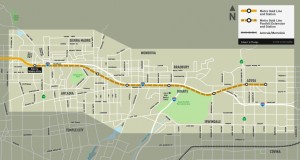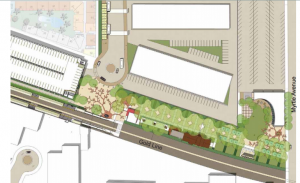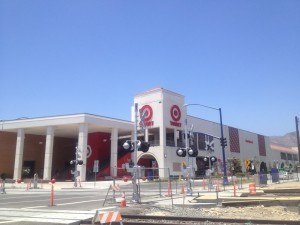Saturday was a day of celebration for rail fans in the San Gabriel Valley in Los Angeles. The Gold Line extension from Pasadena to Azusa opened, marred only by apparently long lines to get the return train home and then later by a big rig crash on the freeway that shut the whole line down.
But while some rail fans celebrate, I’ll have to be the Debbie Downer here. The Gold Line extension should not have been built as rail, and it was solely the result of a political compromise needed to fund rail in other more meritorious parts of Los Angeles County. It brings rail to a low-density part of the county that would be more economically served by bus rapid transit or even commuter buses running in the right-of-way, at probably 20 percent of the costs of rail.
From the beginning, as I documented in my book Railtown, the Gold Line from Union Station to Pasadena was motivated by politics more than ridership. Higher ridership lines in other parts of the county were bypassed because the Pasadena route had powerful political backers, from then-Mayor Riordan to Republican representative David Dreier, who offered critical bipartisan support for rail in the U.S. Congress because he wanted it to serve his district.
Then this extension came along. Why build rail here, in this low-density part of the county (see the video above to check out the lack of development along the route)? Back in 2008, rail boosters needed two-thirds support from the county voters for the sales tax increase known as Measure R. The measure would fund important transit projects all around the county, from the Purple Line subway to the Expo Line to Santa Monica.
But San Gabriel Valley leaders threw a fit, and they almost refused to authorize the measure for the ballot, using their allies on the county board of supervisors and in Sacramento to threaten to torpedo the whole thing for everyone.
Why? They felt that they weren’t going to get any projects out of the measure. But in reality, they were slated to get this gold-plated rail line, even though they didn’t deserve it. They were like hostage takers who wanted 100% assurance they’d get their ransom, and this line was it.
Eventually they came around, with much cajoling, and Measure R passed with over two-thirds support. But this project is the consequence of Prop 13, which requires these voter super majorities. Much compromise is required, and therefore some waste of public funds.
In some ways, the Gold Line extension is the price the region has to pay to have more cost-effective rail lines in densely populated parts of the county. And now that the rail line is up, hopefully local leaders will do everything they can to build more housing and offices near the stations. That’s the best (and only) way to salvage this investment.
And if that happens, then the real celebrating can start.
 The political bargaining to make LA’s rail system happen meant that transit leaders had to greenlight some lame rail lines. How else can you get to 2/3 support for a county sales tax measure if you don’t throw a bone to every region? The poster child is the Gold Line, first to Pasadena and now extending into the suburban San Gabriel Valley at Azusa (Everything from “A” to “Z” in the “USA”) (map to the left).
The political bargaining to make LA’s rail system happen meant that transit leaders had to greenlight some lame rail lines. How else can you get to 2/3 support for a county sales tax measure if you don’t throw a bone to every region? The poster child is the Gold Line, first to Pasadena and now extending into the suburban San Gabriel Valley at Azusa (Everything from “A” to “Z” in the “USA”) (map to the left).
As I document in my book Railtown, the line got approval over more densely populated and higher transit-reliant parts of LA due to political support from Republican Rep. David Dreier and a host of state and local pols from the Pasadena area. Dreier was the rare Republican in favor of rail, because he wanted the line to eventually serve his San Gabriel Valley constituents. The hope among Gold Line boosters is to extend it out to the under-utilized Ontario Airport.
Streetsblog LA recently took a tour of the station areas along the new extension. The photos they took, as well as the renderings of planned development, show why this line is so unfortunate. There’s very little hope in the near future that any kind of density will happen around the stations, which is what is required to maximize ridership and get both a social and economic return on the expensive investment in rail.
Some lowlights (with photos):
- A Monrovia Square development that essentially looks like a giant parking lot with a building in the middle;
- A low-rise, sprawling retail center in Azusa, featuring a giant Target store.
Nowhere to be found are the kind of exciting new neighborhood plans or development, with clusters of 5-6 story residential and office buildings, necessary for light rail station areas. In fact, they would probably seem out of place in the low-rise suburbs there anyway, further underscoring why this line was a bad idea compared to other transit corridors in urban LA. In retrospect, a bus rapid transit line would have made more sense for this corridor. But at the very least, local leaders should show more ambition for development around the stations, now that we have the line.




